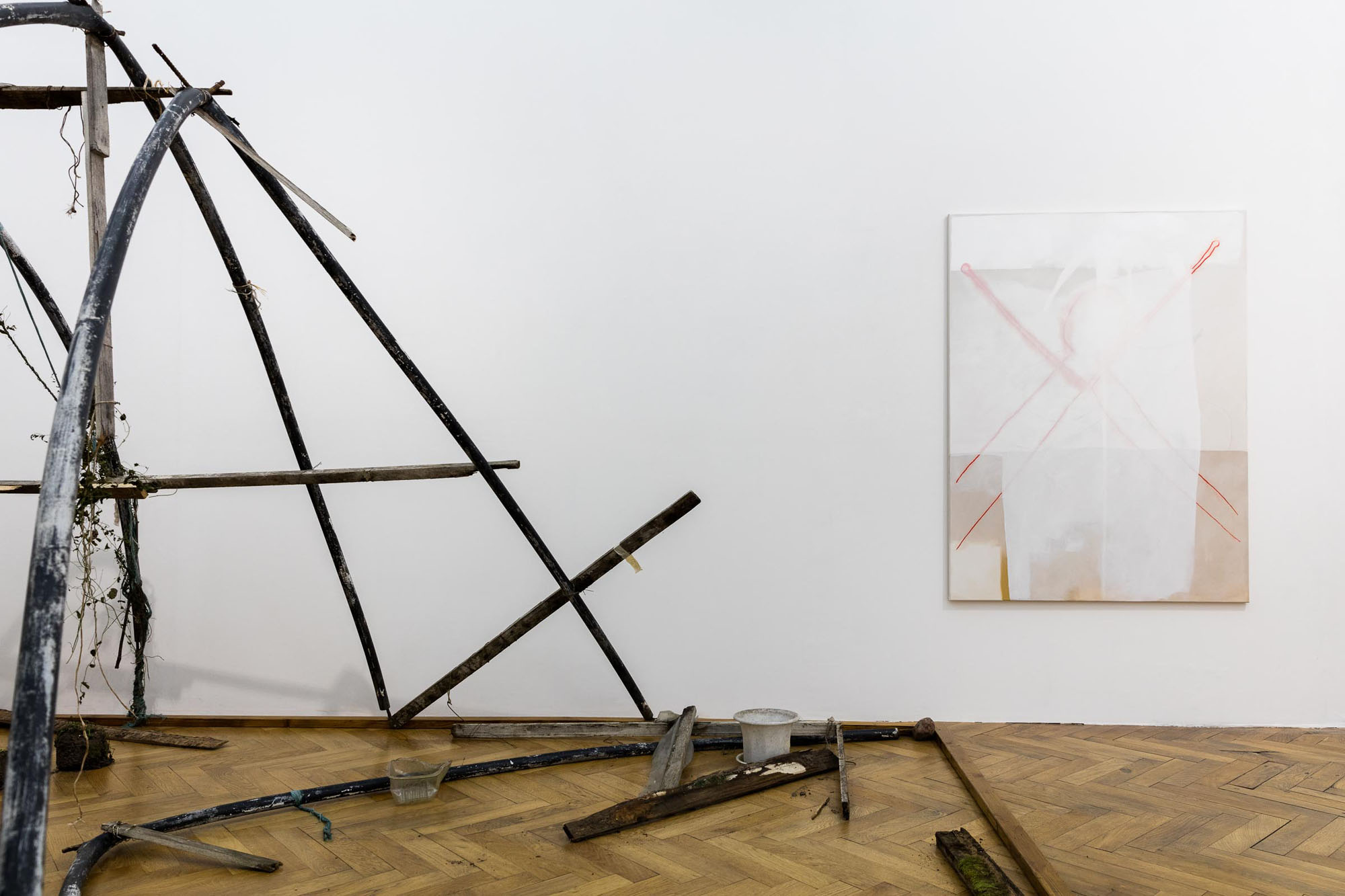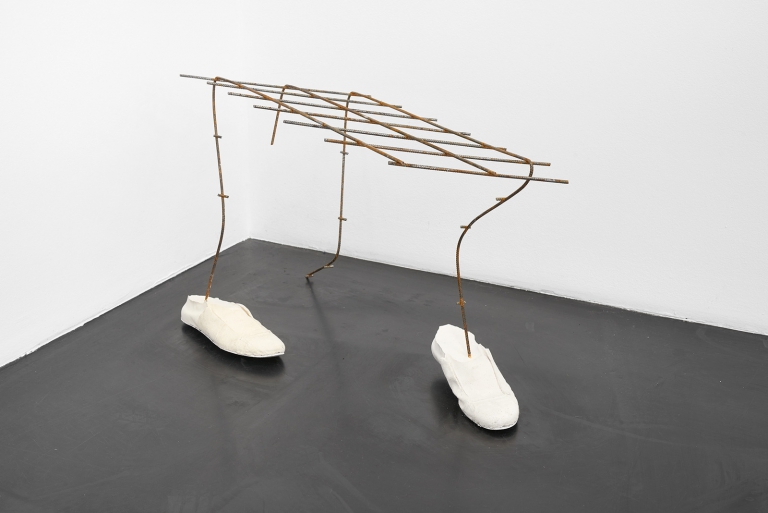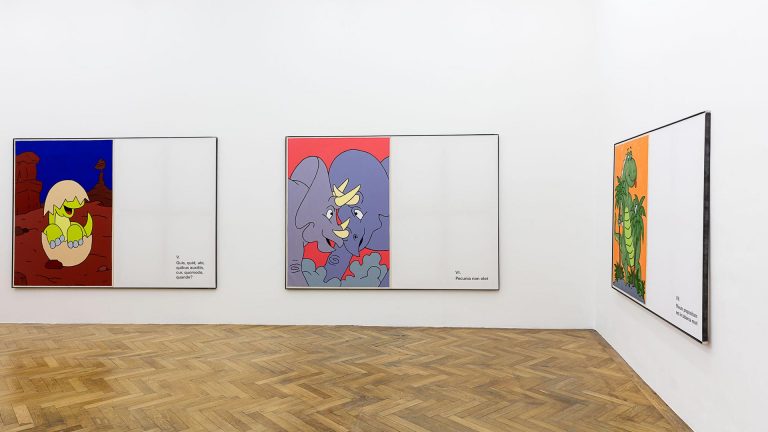Artists: Augustas Serapinas, Malte Zenses
Exhibition title: VARIOUS OTHERS: Augustas Serapinas & Malte Zenses
Venue: SPERLING, Munich, Germany
Date: September 14 – October 26, 2019
Photography: ©the artists. Courtesy of SPERLING, Munich. Photos by Sebastian Kissel
In September 2019, a weathered greenhouse near Vilnius was relocated to SPERLING in Munich. The fragile skeletal structure and the plants it contained come from an abandoned property. Since the landowners left it, weeds have taken over the grounds. Although it was sold to investors some time ago the land has continued to grow wild whilst a suitable use for it is found. The changes made to such found situations characterise the work of the Lithuanian artist, Augustas Serapinas. His deceptively simple artistic gestures often culminate in socio-politically charged works that present an alternative perspective to current conditions (such as the inevitable gen-trification of Vilnius).
For Various Others 2019, Augustas Serapinas will extend his intervention in collaboration with Malte Zenses u-sing a self-made object for the first time: A glass panel set inside a wooden window-frame hangs on the walls of the exhibition space alongside Zenses’ oil paintings that are mounted behind glass. Serapinas’ glass panel came into being by translating a conceptual gesture into a technical operation. The window glass and the immortalised plants were removed from a neglected building (just like the greenhouse) and heated in a kiln together with colou-red pigments until an amalgam of different hues, air bubbles and ash were formed. Thus, the burnt plants left behind a trace of their own self in the very moment of their own disappearance.
This paradoxical principle of preservation through destruction also correlates with the relocation of the green-house. Although it is essentially useless and broken, it was nonetheless transferred to the gallery space with great logistical effort and rebuilt there to be conserved for a certain amount of time in a foreign environment. In this way Serapinas temporarily intervenes in the biography of both living and lifeless objects. He aims to abstract singular elements from a given situation and looks to reassemble them in new ways.
The wooden window-frame, the glass panel and the weeds fuse together to become objects on a wall, which are not only comments on the greenhouse and the plants which live within it, but also on the social situation at their place of origin. In doing so, Serapinas is recording a conflict between Man and Nature in which one party domina-tes the other. By using a chemical process, Augustas Serapinas turns glass into an archival document as it bears the traces of an intermediate stage in his work.
Meanwhile, in the works of Malte Zenses, glass is used to make a clear distinction between the one and the other, thereby becoming a physical ‘separating’ element. In semiotic terms, Zenses’ paired paintings titled, ‘Orgelblut 1 and 2’ (2019) and ‘With Karin at Golf 1 and 2’ (2019) are barely distinguishable. On one canvas a red anthropo-morphic form appears to raise its arms as a warning sign whilst on the other, it seems to disappear behind a screen. A dark, bridge-like form scales two further paintings and links the sound-holes of a depicted string instru-ment. Whilst the image is clearly discernible on one canvas, it is blurred on the other under multiple layers of paint and a frosted glass cover. Fine black lines can be seen scattered on the paintings but they do not disclose any information to help decipher the images.
Malte Zenses develops these code systems (in as much as they are systems) in sketches, notes and personal observations. They do not offer the viewer a distinct meaning but rather create an interaction between various visual references. The boundaries between the individual works are blurred and eventually fuse together to form a whole.
Oil paint is applied to all the canvases in several thin layers but none of them are entirely covered with it. This creates the impression that each coat of colour was individually applied and that the images were composed layer by layer. The paintings oscillate between inner and outer, or rather, between before and after. The letters, ‘P’, ‘O’, ’S’ and ’T’ have been carefully applied and can each be recognised in one of the works. Whether these letters refer to the prefix “post,” or to the command, “stop,” remains a matter of speculation.
That is the ambiguity which the framing of the two paintings seeks to achieve. Behind the milky glass they are still clearly visible from afar but on closer inspection, they disappear almost entirely under a white veil. This effect is further reinforced by the paintings’ unframed companions. It catapults Zenses’ work from the two-dimensional surface into a three-dimensional space. The glass either opens or closes the view and creates — like a window — an inside or an outside. If one walks past Zenses’ paintings, their motif tends to disappear and re-manifest itself behind the glass depending on the angle of vision. In other words, the painting vanishes before your own eyes. Meanwhile, Augustus Serapinas’ windows do not open up a view to the outside, but they enclose that which otherwise grows in front of the windowsill, in the conservatory.
In their artistic collaboration, Malte Zenses and Augustas Serapinas somewhat elevate themselves to the position of artistic alchemists. They both bring together individual elements in their works in a new way. By using glass, they transform one observational situation into another as well as providing the key to each other’s work.
—
“But he would rather continue experimenting with that fine line that hovers between the materiality and immateria-lity of glass, making it disappear and leaving nothing but its properties. Only such alchemy is worth all the effort. Only this reveals the ambiguity of the world.” (Patricia Görg: Glass, an Art, Die Andere Biblothek, Berlin 2013)
Augustas Serapinas, Malte Zenses, 2019, exhibition view, SPERLING, Munich
Augustas Serapinas, Malte Zenses, 2019, exhibition view, SPERLING, Munich
Augustas Serapinas, Malte Zenses, 2019, exhibition view, SPERLING, Munich
Augustas Serapinas, Malte Zenses, 2019, exhibition view, SPERLING, Munich
Augustas Serapinas, Malte Zenses, 2019, exhibition view, SPERLING, Munich
Augustas Serapinas, Malte Zenses, 2019, exhibition view, SPERLING, Munich
Augustas Serapinas, Malte Zenses, 2019, exhibition view, SPERLING, Munich
Augustas Serapinas, Malte Zenses, 2019, exhibition view, SPERLING, Munich
Augustas Serapinas, Malte Zenses, 2019, exhibition view, SPERLING, Munich
Augustas Serapinas, Notes from Uzupis 2, 2019, reclaimed wood, stained glass, 98 x 46 cm
Malte Zenses, Mit Karin im Golf, 2019, oil and pencil on canvas, 160 x 120 cm
Malte Zenses, Mit Karin im Golf II, 2019, oil and pencil and spray-paint on canvas, 160 x 120 cm
Malte Zenses, Orgelblut, 2019, oil and pencil on canvas, opal glass and maple wood, 166 x 136 cm



















